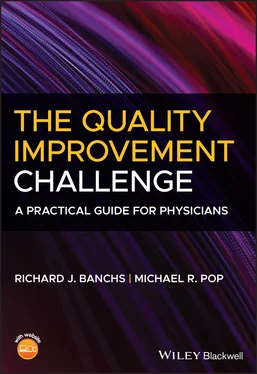A lack of active participation of senior hospital leaders. The role of the leader is to legitimize improvement projects and facilitate the work of the improvement team. The leader establishes priorities for competing initiatives; provides resources for the team; resolves cross‐functional issues, and removes roadblocks that impede the success of the project. Senior leaders in healthcare are often not visible, active, or engaged in QI projects. When leaders are not present, projects flounder, have difficulty reaching their objectives, and often fail. Leaders are vital in building a coalition of key sponsors to achieve project success and facilitating change.
A lack of improvement experience. Healthcare professionals often lack the experience and formal training needed to address the complex performance problems of the healthcare delivery system. Postgraduate healthcare education continues to be almost exclusively focused on the acquisition of scientific and clinical facts, and has not included the knowledge and skills that define competency in improvement work. QI competency needs to be developed with rigor, heightened focus, and consistency like any other discipline. Because they lack experience, often staff and providers rely on their subject‐matter expertise to complete a QI project. They fail to follow the required structured systematic approach and cannot achieve the goals of the improvement initiative. Improvement knowledge does not come as a natural evolution of clinical expertise. Improvement capability is not a natural ability!
The team dynamics. QI teams in healthcare are often multidisciplinary in nature and are convened in an ad‐hoc manner, from different areas or departments. There is usually very little time to ensure cohesive functioning of the team members to avoid “silo” mentality. Physicians, nurses, staff, and administrators are brought together and expected to work as a team, even if they have never done so in the clinical arena.
A top‐down approach to improvement. With multiple competing clinical priorities, improvement projects are often left in the hands of leaders and small teams of specialized subject‐matter experts (SMEs). This traditional model is no longer effective and cannot achieve the operational improvements in the large scale that are needed in today’s healthcare organizations. Engagement of the front line is critical to succeed and, yet, is not always present. This traditional approach to QI perpetuates the belief that process improvement is the responsibility of a small number of individuals in the organization and it does not have the same critical nature as the “clinical side” of care. Even when the front line is engaged, organizations don’t provide sufficient time, resources, or support. It becomes challenging to convene regular meetings with key stakeholders who must juggle their clinical and nonclinical responsibilities with project activities.
Lack of a robust change management strategy. There is often more focus on the technical or clinical aspects of the problem than on how the solution will be received by the front line. It is important to remember that all improvement is a change, and change is going to have a significant effect on the professionals in the front line. Change management is often an afterthought, with the main focus being on designing, testing, and deploying the solution that addresses the needs of the project. Managing the effects of change is often reactive, and implemented without a clear plan. Communication and engagement with the front lines is not given sufficient emphasis leaving the project team unable to implement the much‐needed solution.
Too many competing initiatives. In healthcare, there are too many competing initiatives that result in improvement fatigue. Healthcare providers face a constant barrage of mandates to change practice from external stakeholders, including accrediting organizations, regulatory bodies, third‐party payers, and professional associations. Front lines often become overwhelmed by the number of changes that occur in their work routines. There is a lack of leadership with proper selection, stratification, and improvement focus at the front line.
Excessive focus on the methodology rather than the improvement opportunity. In the late 1980s, healthcare organizations began incorporating industrial quality‐management methodologies including Lean, Six Sigma, and Lean Six Sigma in their strategies to improve delivery of care. The Lean Six Sigma approach attempts to address the non‐value‐added activities, inefficient workflows, and disorganized work environments that interfere with clinicians’ ability to provide safe, high‐quality patient care. It merges the customer‐orientation and waste‐reduction techniques of Lean (time‐driven focus) with the more statistical and data‐driven systematic error reduction strategies of Six Sigma (quality‐driven focus). When implemented as an overarching management system and organizational philosophy, Lean Six Sigma process improvement methodology has been shown to improve patients’ experience, staff and providers’ work environment, and the quality of patient care (Nicolay 2012). Not all QI projects have been successful using Lean Six Sigma. Some teams have had disappointing results. For these teams, Lean Six Sigma lacked some of the critical elements they needed for success. When applied to medicine, industrial quality management methodologies have several problems:Heavy use of technical and business terminology. These improvement methodologies are derived from the manufacturing sector and often carry with them an overemphasis on improvement jargon that seems complex, counterintuitive, and far removed from the clinician’s front line.Improvement is often carried out by small teams of certified Lean Six Sigma practitioners who make up their own distinct department. These SMEs lead improvement efforts in a “top‐down” approach but often fail to create the conditions for the front line stakeholders to engage. Changes are pushed through without the front line professionals’ involvement in developing, revising, or monitoring the performance of key processes.
Physicians have a limited understanding of these improvement methodologies and in general regard them as something outside of the scope of medicine, showing little interest in learning them. Most industries make great products with average employees working with brilliant processes. Healthcare does great work with brilliant employees working with mediocre processes .
WHAT IS THE PHYSICIAN’S ROLE IN PROCESS IMPROVEMENT?
It is widely accepted that physician engagement is an essential requirement for any successful quality improvement project, and yet we have not seen the full engagement of clinicians. Physicians have a pivotal role within the organization. However, they are often not involved in healthcare organization improvement efforts, either because of the constraints of their overbooked clinical schedules or because of the perception that they are not directly responsible for the improvement of the operational aspects of delivering care.
Physicians express a strong support for QI projects, but often have a different view of what this entails. Although this is probably not you (the reader!), physicians in general
View improvement projects as taking time away from patient care, interfering with their schedule, and adding complexity to their workflow, even when that very workflow is the cause of the problem. This unfavorable view of QI projects is further perpetuated when their improvement efforts are not recognized with professional advancement or other incentives.
Are often reluctant to participate in QI projects because they believe the improvement initiative will be ineffective.
View quality assessment as an integral element of the practice of medicine and resist any improvement initiative that challenges this view.
Читать дальше












